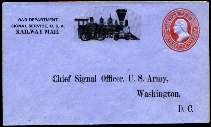

War Department envelopes used in collecting weather data, 1870 - 1890
I bought the first of the envelopes above about twelve years ago, for the train. I was curious what it had been used for, and why the train, but had no idea how to pursue those questions. Then in 1992 I saw one like it, but without the train (like the first one above), in the Linn's Stamp News Collectors Forum - its owner wanted to know it purpose. Linn's gave the following information at that time:
The War Department envelope is the embossed 3¢ red Washington on blue paper produced by Plimpton Manufacturing Co. in 1875. (The short queue behind Washington's head makes it easy to distinguish from the 1873 envelopes made by George H. Reay.) The Scott catalog lists the basic item under Official envelopes as Scott UO54, with a catalog value of $2.50 unused and $2 used. No catalog or other reference of which we are aware lists the myriad special-purpose printings by means of which this and other Official envelopes were prepared to serve some official function or other, usually involving the gathering and return of official information to Washington, D.C. Some alert collector may be able to tell you the use for which this envelope was prepared. But no guide to the many hundreds, or perhaps even thousands, of various Official postal stationery printings, let alone their purposes, has ever been compiled.
A month or two later Linn's printed the following additional information:
Brad Arch, editor of the Long Island Postal Historian, quarterly Journal of the Long Island Postal History Society, had the answer in an article in the Fall 1991 Issue of his Journal. The article, titled "Mail Services to the Early Weather Bureaus," is described as "By: Edith Doane" with "Illustrations from the 'J. Fred Rodriguez' Collection," although Doane died Dec. 29, 1983.
On Feb. 5, 1870, Congress charged the War Department with the job of recording weather information from throughout the country. Writes Doane, "The newly authorized Weather Bureau was then assigned to the War Department's Signal Service and put in charge of the Chief Signal Officer, to whom were transferred the accumulated records of many volunteer weather observers. The Signal Service continued to administer the weather program for the following 20 years." "Form 29" appears to have been the form used for the submission of weekly weather reports to Washington, D.C. The article Illustrates at least five different types of preprinted envelopes used for this function. The article Illustrates four War Department envelopes with the three-line "Railway Bulletins" corner card of the type submitted by Devine. All four were used between September 1884 and June 1885, which suggests a likely period of use. "On July 1, 1891." Doane notes, "also by Congressional action, the weather program was turned over to the newly created Weather Bureau of the Department of Agriculture." Apparently unused War Department stationery preprinted for use in mailing weather reports got into collector hands after the War Department ceased compiling meteorological Information, when envelopes like this were no longer needed.
Two of my envelopes reference Form 125B, instead of form 29. Those also say "Monthly Reports", so presumably that was the distinction.
This still does not explain the train, of course, and Linn's did not mention it, so either none of their envelopes had it, or they did not consider it important. My theory is that the train was added to give the envelope more importance, i.e., make the envelope more noticeable, so it would be opened sooner.
If you got to this page via the link on my Trains on Advertising Covers page, close this window to return to its parent.
If you got here some other way, please visit my page titled Trains on Advertising Covers.
All text Copyright © 2000, William M. Senkus
Send feedback to the webmaster: CLICK HERE
Revised -- 01/09/2002





